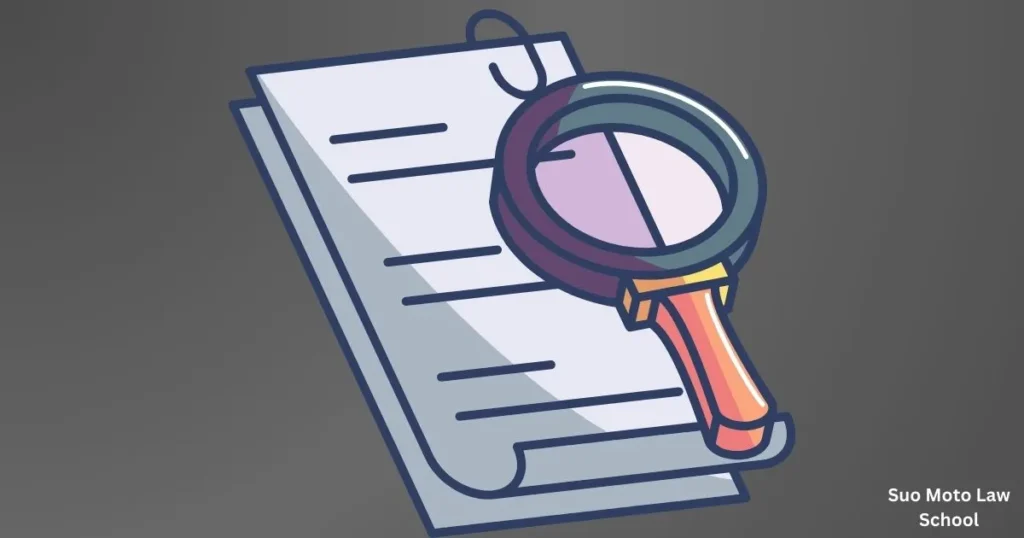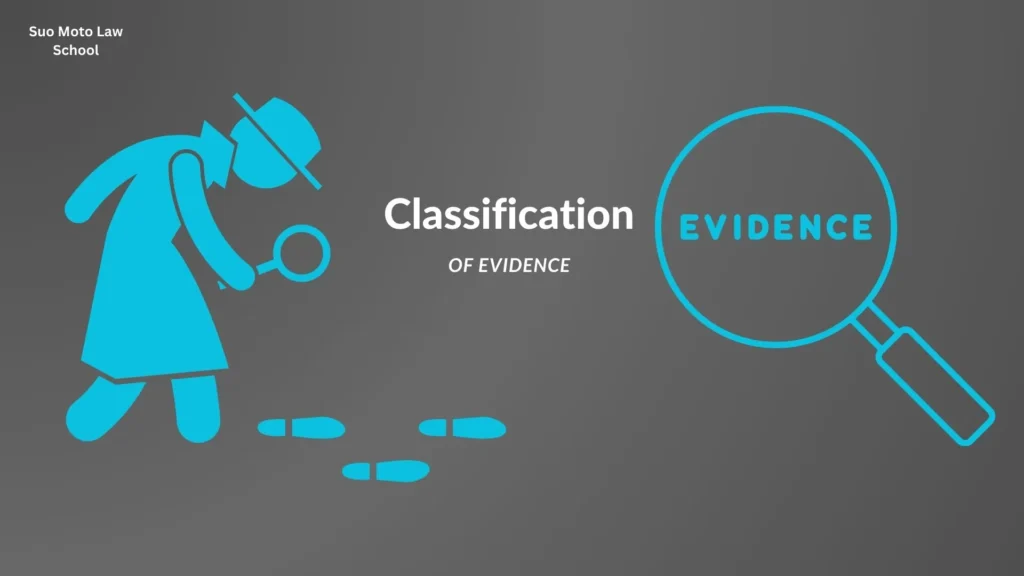Definition of Evidence
The term ‘evidence’ means anything by which any alleged matter of fact is either established or disproved. In one sense, evidence means a fact by which another fact is proved or disproved. In another sense, evidence does not mean any fact’ rather it is the reason for the proof of facts for judicial determination of disputes. Following are some important definitions of evidence by legal experts:
According to Nokes, ‘Evidence is the facts which are legally admissible and the legal means of attempting to prove such facts.”
According to Phipson ‘Evidence, in the first sense, means the testimony, whether oral, documentary or real, which may be legally received in order to prove or disprove some fact in dispute.”
According to Halsbury’s Laws of England, “The usual means of proving or disproving a fact or matter in issue.”
Salmond says, “One fact is evidence to another when it tends in any degree to render the existence of that other probable. That quality by virtue of which it has such an effect may be called its ‘probative force’, and evidence may therefore be defined as any fact which possesses such force.”
According to Curzon, “Evidence is considered as the legally admissible facts into which the court will enquire the legal means of attempting to prove or disprove those facts before the court and the resultant corpus of rules of law attaching thereto.”
Section 3 of the Evidence Act 1872 defines evidence as follows:
“Evidence” means and includes-
- All statements that the Court permits or requires to be made before it by witnesses, in relation to matters of fact under inquiry; such statements are called oral evidence;
- All documents produced for the inspection of the Court; such documents are called documentary evidence. DIGITAL [AMENDMEMT-2022]
- All materials or objects relating to blood, semen, hair, all body material, organ or part of organ, Deoxyribo Nucleic Acid (DNA), finger impression, palm impression, iris impression and footprint or any other similar material or object which may- (i) establish that an offense has been committed or establish a link or relation between an offense and its victim or an offense and its offender; and (ii) prove or disprove a fact: such materials or objects are called physical or forensic evidence.
Section 3 thus gives a statement of what the term ‘evidence includes; however, it does not define in the true sense what actually evidence is. The statement given in section 3 is a statement of some kinds of evidence rather than the definition of evidence. Section 3 includes only two kings of evidence, i.e., statements of witnesses (oral evidence and documents (documentary evidence). But this does not mean that there cannot be any other kinds of evidence.
For example, when a judge inspects the scene of occurrence and draws a chart of it, that is also a piece of evidence though it is neither an oral statement of a witness nor a document produced by the parties. Thus, the definition of evidence given in section 3 is not exhaustive.

Classification of Evidence
As mentioned above, the Evidence Act divides evidence into two classes: oral and documentary. However, there is no specific statutory classification of evidence. Classification tends to reflect a textbook writer’s individual preferences. The following classifications are adopted below:
- Direct and circumstantial evidence;
- Oral and documentary evidence;
- Primary and secondary evidence;
- Physical Evidence and Testimonial Evidence;
- Substantive Evidence and Procedural Evidence.
Direct and Circumstantial Evidence
Direct evidence is also called positive or original evidence. On the other hand, circumstantial evidence is also called indirect or presumptive evidence. Every judicial evidence is either direct or circumstantial. Direct evidence is the testimony of a witness to the existence or non-existence of the facts in issue; circumstantial evidence is the testimony of a witness to other facts from which the facts in issue may be inferred.
In other words, when evidence is given of the very fact in issue, i.e. of the matter in controversy, it is called direct evidence, and when evidence is given of circumstances, or relevant facts, from which an inference may be drawn about the fact in issue, then it is called circumstantial evidence. By allowing evidence to be given of relevant facts, the Evidence Act deals with and allows circumstantial evidence. Circumstantial evidence is evidence received from facts that are so closely connected with the facts in issue that, it is reasonable to infer from their existence the existence of the fact in issue.
Circumstantial evidence is of two kinds: (i) Conclusive, when the connection between the principal and evidentiary facts is the necessary consequence of the laws of nature; and (ii) presumptive, when the inference of the principal fact from the evidentiary is only probable.
Example 1:
In Y’s murder case-
(i) A saw Y’s dead body floating on a river. – This is circumstantial evidence.
(ii) B saw C stabbing Y with a knife. – Here B’s evidence is direct.
Example 2:
For example, in a murder case, if the witnesses say that they saw the accused inflict the blow that caused the death, or in a case of cattle theft, the witnesses depose to have seen the accused stealing and taking away the stolen cattle, it is called the direct evidence. Similarly, in a suit on an agreement the statement of a witness that the agreement was entered into in his presence and he witnessed it, or in the case of the recovery of a loan, the evidence of the person who saw the loan advanced is direct or positive evidence.
For example, A is charged with the murder of B by stabbing him. C, D, E, F, G, and H are witnesses called by the prosecution.
i. C says he saw A stabbing B.
ii. D says he heard B crying out that A was stabbing him.
iii. E says that he saw A running away with a blood-stained knife and blood-stained clothes.
iv. F says that he saw A washing his blood-stained clothes.
v. G is a doctor who says that the knife found in A’s possession might have caused the wounds found on B; and
vi. He says that he heard from C and C saw A stabbing B. If we use the phrases ‘direct evidence’ and ‘circumstantial evidence’, the evidence given by C is direct evidence and that given by others is circumstantial evidence. Because C gives evidence of the very matter in controversy, whereas D to H gives evidence of circumstances which, if believed, would assist the court in drawing an inference about the matter in controversy (death/killing).
Again, if we use ‘direct evidence’ as used in section 60, then the evidence of C to G is direct evidence and that of H is indirect evidence. This is because each of them, C to G is giving evidence about a fact that was perceived by him by a particular sense by which it was capable of being perceived; Whereas H alone is giving hearsay evidence as he himself has not seen and it is not admissible as evidence.
Conviction Based on Circumstantial Evidence
Circumstantial evidence must be inconsistent with any probable inference of the innocence of the accused. That means circumstantial evidence has to show that the accused ‘must have’, and not ‘may have’, committed the crime for which he is indicted. In Taslimuddin vs. State (44 DLR 136) his Lordship Habibur Rahman Khan, J. observed:
‘The law on the point is now well settled. To put it in the words of Munir CJ. Expressed himself in the case reported in PLD 1950 Lahore 288 (FB) in the following language:
“To find a man guilty of a criminal offense on circumstantial evidence the facts proved must be consistent with the theory of guilt and incompatible with the theory of innocence.” It is further observed in the case, “no man is to be found guilty on circumstantial evidence unless the circumstances established against him are such that no reasonable hypothesis other than guilt can be built upon them”.
In the case of Eradu and others Vs. The state of Hyderabad reported in PLD (SC) 286 that the Supreme Court held:
“It is the fundamental principle of criminal jurisprudence that circumstantial evidence should point inevitably to the conclusion that the accused and the accused only were the perpetrators of the offense and, as such, evidence should be incompatible with the innocence of the accused.”
Circumstantial evidence is ‘indirect evidence’ and it is admitted when no direct evidence is available. There is no direct testimony against the accused, but only some facts which afford an inference or presumption of his involvement in the criminal act. It is, therefore, necessary that every circumstance must be shown to be really connected with the hypothesis it is supposed to support.

Real Evidence
This is also called physical evidence. When a physical object is produced for the court’s inspection, this is called real evidence. This term embraces material objects, the appearance of persons, the demeanor of witnesses, views of machinery, buildings, and landscapes, and various types of mechanical records and output that do not involve the intervention of the human mind. Real evidence includes the following:
- Material objects (for example, blood, knife, weapon, etc.).
- Appearance of persons (a person’s appearance like his height, build, coloring, the presence of facial hair or scars may provide the identity of that person).
- The demeanor of the Witness (the attitude of a witness and the way the witness answers the questions- whether he or she is clear or confused, helpful or evasive, confident or nervous, etc.- have been thought to be useful guides to the weight that can be placed on the witness’s evidence.).
- Views and Reconstructions (A view is an inspection by the court of an object or place outside the courtroom during a trial. Objects inspected in this way include, for example, things that are impossible or inconvenient to produce in court, such as vehicles or factory machines, etc. Similarly, visits by the court to the scene of an accident or a crime or to land which is the subject of litigation, may take place during a trial.).
- Mechanical recording and computer outputs (photographs, audiotapes, films, videotapes, computer printouts, etc. are examples of such types of evidence.).
Substantive Evidence and Procedural/Corroborative Evidence
Corroborative evidence must be taken along with substantive evidence. When evidence Is given of the fact in issue or of a relevant fact, that is called substantive evidence. In other words, when a judgment or conviction may be given by the court based on a particular evidence, that evidence is called substantive evidence. There are, however, several statements, oral and documentary, which are not substantive evidence. They are not admissible by themselves but become admissible to corroborate or support substantive evidence already given.
For instance, if A makes a complaint (ejahar) in the police station and based on that ejahar a case is filed in the court against B. Now A would be the principal witness in this case and his testimonial evidence in the court would be substantive evidence and his complaint (ejahar) filed at the police station would be corroborative evidence. The complaint or ejahar by itself is not evidence and if A does not come to the court to give testimonial evidence, the complaint or ejahar remains a mere hearsay evidence and would be inadmissible. Evidence to corroborate substantive evidence is permitted under sections 156 and 157.
Original and Derivative Evidence
According to Best, the division of evidence into original and unoriginal or derivative evidence runs through the whole system of English forensic procedure. By original evidence, it means evidence that has independent probative force of its own. Unoriginal, derivative, transmitted, or second-hand evidence is that which derives its own force from other sources. There are five forms of derivative evidence:
- When supposed oral evidence is delivered through oral; this is hearsay evidence, in the strict and primary sense of the term;
- When supposed written evidence is delivered through written.
- When supposed oral evidence is delivered through written.
- When supposed written evidence is delivered orally.
- When real evidence is reported, either by word of mouth or otherwise.
The infirmity of derivative evidence as compared with its primary source will be obvious concerning the common instance of supposed oral evidence delivered through oral. A deposes that B told him that he witnessed a certain fact. If B were the deposing witness there would be only two chances of error in believing the testimony – (a) that he may have been mistaken as to what he thought he witnessed; or (b) that his narrative may be intentionally false.
But when his testimony comes to us through the relation of A, two fresh chances of error are introduced; viz. that A may have either mistaken the words uttered by B or may intend to misrepresent them. The danger increases, the greater the number of media through which evidence has come; for with each additional witness or other medium, fresh chances or errors are introduced.

